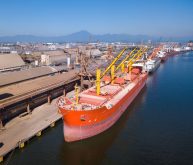LONDON, U.K. (Reuters) — The shipping industry lacks clarity on future clean fuels and regulatory systems, which is holding back companies from replacing aging vessels amid pressure to decarbonise faster, a United Nations agency says.
Shipping, which transports more than 80 percent of world trade and accounts for nearly three percent of the world’s carbon dioxide emissions, has faced calls from environmentalists and investors to deliver more concrete action, including a carbon levy.
“We call for global action to decarbonise shipping. However, we recognize that this is not an easy task and also the cost that can be associated with it,” the agency’s secretary-general, Rebeca Grynspan, told a news conference in London.
Read Also

Using artificial intelligence in agriculture starts with the right data
Good data is critical as the agriculture sector increasingly adopts new AI technology to drive efficiency, sustainability and trust across all levels of the value chain.
In its Review of Maritime Transport for 2023, the UN Conference on Trade and Development (UNCTAD) said it was concerned over the aging global shipping fleet.
At the start of 2023, commercial ships were on average 22.2 years old, two years older than a decade ago, according to the report.
“More than half of the world’s fleet is over 15 years old,” UNCTAD said.
“Shipowners face the challenge of renewing the fleet without clarity regarding alternative fuels, green technology and regulatory regimes to guide ship owners and ports, while port terminals face similar challenges in vital investment decisions.”
In July, countries adopted a revised greenhouse gas strategy for shipping that set a net zero emissions target by or around the middle of the century, which was seen by environmental groups as not ambitious enough.
Decarbonizing shipping by 2050 will require large investment, and the UNCTAD report cited estimates from Norwegian risk manager DNV indicating additional annual costs of US$8 to $28 billion to enable ships to reach that target.
The industry is exploring several technologies, including ammonia and methanol, in an effort to move away from dirtier bunker fuel. Wind-assisted propulsion is another clean energy option being looked at.
UNCTAD’S report said that scaling up fuel production, distribution and marine bunkering infrastructure to supply 100 percent carbon neutral fuels by 2050 would require estimated annual investments of $28 billion to $90 billion.
“Estimates suggest that full decarbonization could raise annual fuel costs by 70 to 100 percent compared to current levels,” UNCTAD said.
“Shipping cannot decarbonize on its own.”
Maritime trade volume contracted marginally by 0.4 percent in 2022 but UNCTAD projected it would grow by 2.4 percent in 2023 with moderated growth of 2.1 to 2.2 percent forecast between 2024-28.















